Sous Vide Pork Loin in Garlic-Herb Marinade
This sous vide pork loin roast in a green garlic-herb marinade is a foolproof way to easily make a restaurant-quality meal at home.
Sous vide cooking has revolutionized how we approach meal preparation, offering a precise and consistent method to achieve restaurant-quality results in the comfort of our kitchens. One dish that truly shines in the sous vide process is pork loin, particularly when infused with a flavorful garlic-herb marinade. In this article, I’ll show you how to use the sous vide method to make the juiciest and most succulent pork loin with a super duper tasty garlic-herb marinade that you can use for any pork cuts.
Understanding Pork Loin Roast
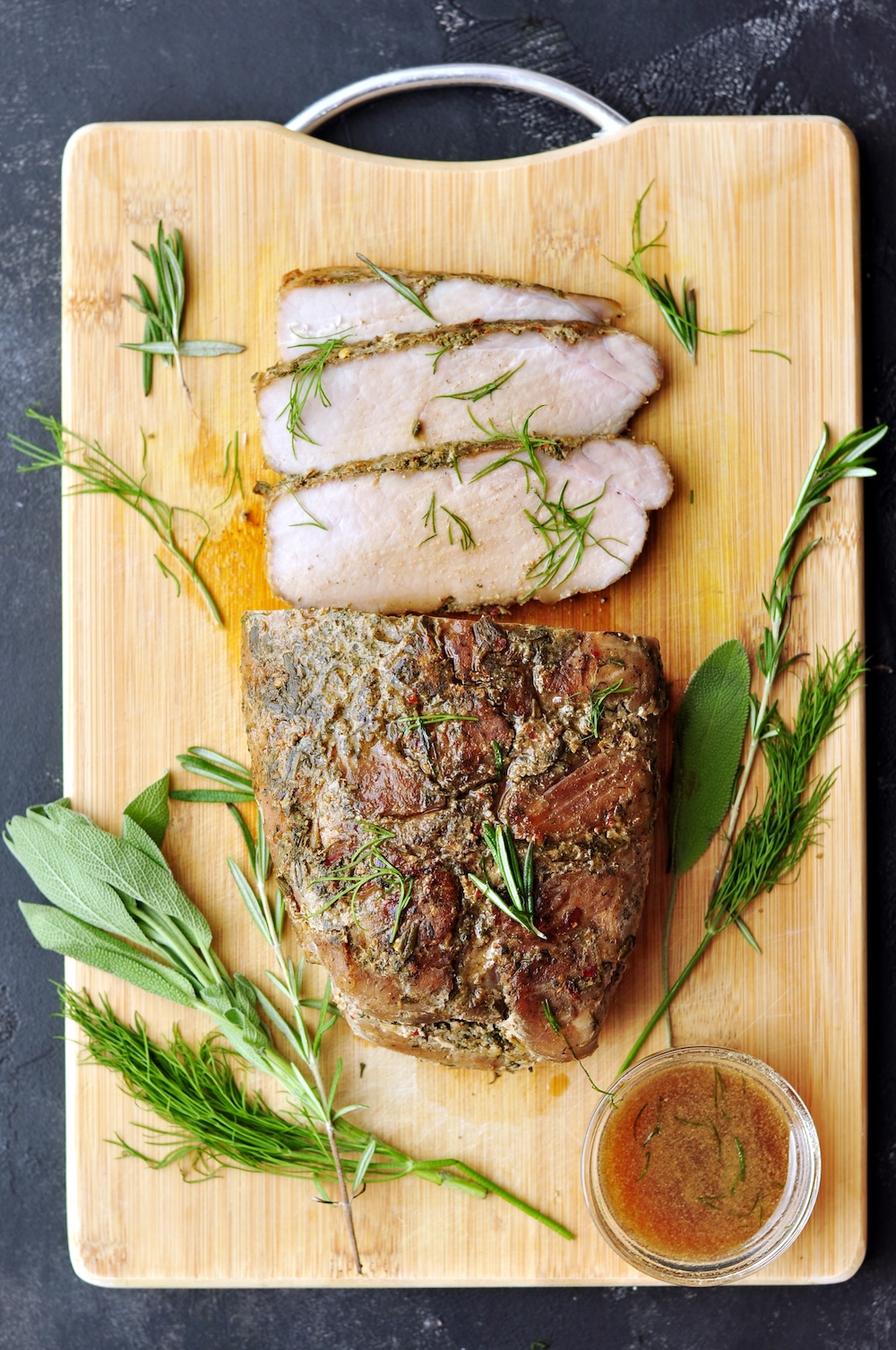
Pork loin roast is a standout cut that deserves attention for impressive, satisfying meals. Typically, it’s a large, boneless cut from the upper part of the pig’s back, known for its balanced lean meat and a delightful fat cap that renders down beautifully during cooking, adding richness and flavor.
It’s important to note that pork loin roast and pork tenderloin are distinct. Pork tenderloin is smaller, leaner, and narrower and comes from a different part of the pig. Both cuts are suited for sous vide cooking, but pork loin roast benefits even more from the slower cooking process to maximize tenderness and flavor.
When selecting a pork loin roast, look for bright pink meat with a thick, even fat cap. This fat adds flavor and keeps the roast moist during cooking.
Aim for a 3-4 pound roast, ideal for 6-8 people or providing leftovers. If you cook for one or two, this recipe freezes well. Larger roasts can be halved for easier management and even cooking—plus, you can freeze one portion for later.
Sous Vide Pork Loin Time and Temprature
Understanding the ideal time and temperature settings for your sous vide pork loin roast is crucial for achieving the desired level of doneness and juiciness. Here’s a detailed guide to help you choose the right settings based on your preference:
Doneness Levels:
| Doneness | Temperature | Time Duration |
| Medium-Rare | 135°F (57°C) | 3-5 hours |
| Medium | 140°F (60°C) | 3-5 hours |
| Medium-Well | 145°F / 63°C | 3-5 hours |
| Well Done | 150°F (65.5°C) | 3-5 hours |
Personal Insights:
- Medium-Rare (135°F / 57°C):
- Texture: Ultra-tender with a rosy pink center.
- Juiciness: Maximum juiciness and very tender.
- Insight: Ideal if you appreciate a steak-like texture in their pork.
- Medium (140°F / 60°C):
- Texture: Tender with a slight pink center.
- Juiciness: Well-balanced; juicy but slightly firmer than medium-rare.
- Insight: This is my preferred setting for pork loin, providing a perfect balance of tenderness and traditional doneness.
- Medium-Well (145°F / 63°C):
- Texture: Less pink, firmer yet tender.
- Juiciness: Still fairly juicy, but starting to firm up more.
- Insight: Great if you prefer pork more on the cooked side but still want to maintain moisture.
- Well Done (150°F / 65.5°C):
- Texture: Fully cooked, white throughout.
- Juiciness: Much firmer, moderately juicy.
- Insight: Best if you prefer fully cooked meat with no pink
What You’ll Need
Essential Ingredients
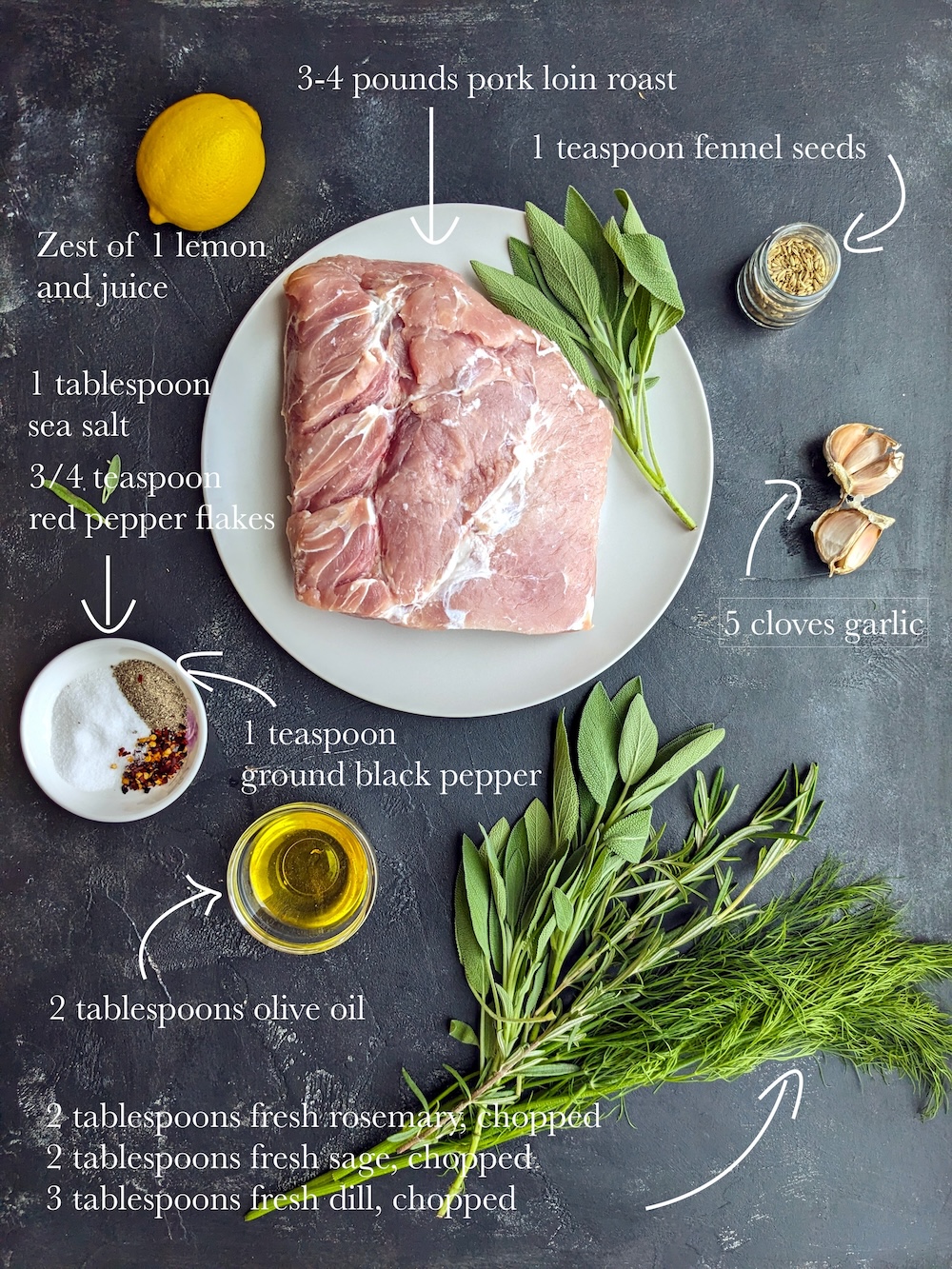
Essential Equipment
To excel at sous vide cooking, the right tools are vital. Here’s a list of essentials:
- Immersion Circulator: My go-to sous vide machine is Anova Precision Cooker.
- Sous Vide Container: Regular stockpots work, but specialized containers like the Anova sous vide container are designed to hold and insulate water efficiently.
- Vacuum Sealer or Ziplock Bags: In my opinion, a vacuum sealer isn’t strictly required for sous vide pork loin, but you can most definitely vacuum seal your pork loin for best results. A high-quality plastic ziptop bag is also effective, especially with the water displacement method.
- Mortar and Pestle or Food Processor: For the garlic-herb marinade, I enjoy the feeling of crushing herbs and spices using a mortar and pestle. A food processor can be more efficient if you prefer.
- Cast-Iron Skillet: If you decide to sear the pork on the stove, use a cast-iron skillet.
- Good Knife: Precise cutting is crucial, and a high-quality chef’s knife is invaluable. I prefer my Global Knife for its balance and sharpness.
If you want to know how to choose the right bags to sous vide different foods, read Sous Vide Bags 101.
How to Make Sous Vide Pork Loin in Garlic-Herb Marinade Step by Step
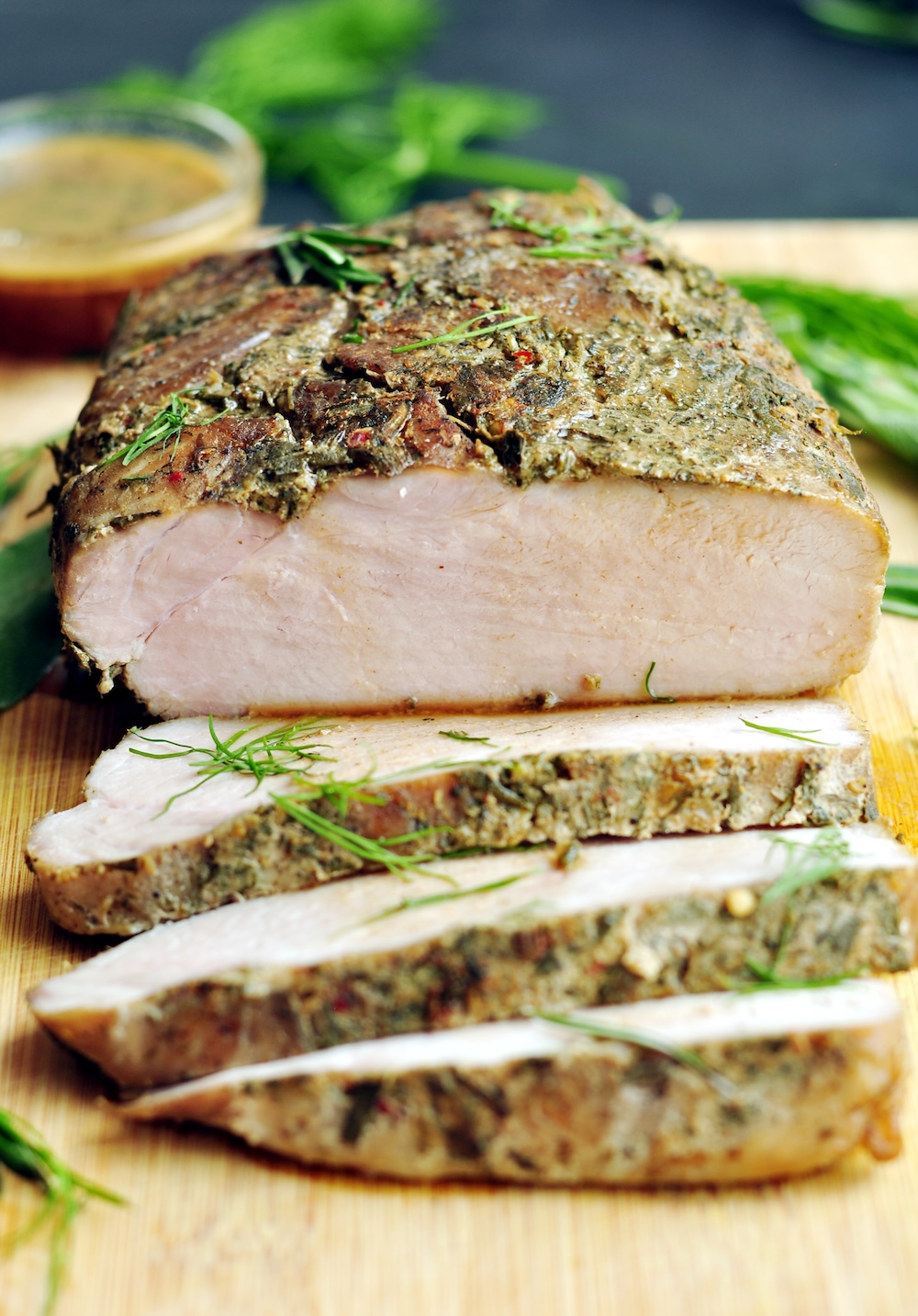
Here’s a breakdown of the cooking process into easy, foolproof steps:
Step 1: Prepare the Garlic-Herb Marinade
Creating a flavorful garlic-herb marinade is key to enhancing the natural taste of the pork loin.
I like using a mortar and pestle to crush the marinade ingredients, but a food processor is much quicker. The key is to aim for a paste consistency so the flavors are well distributed when you rub it all over the pork. This step guarantees that every bite of the pork loin is infused with the rich essence of garlic and herbs.
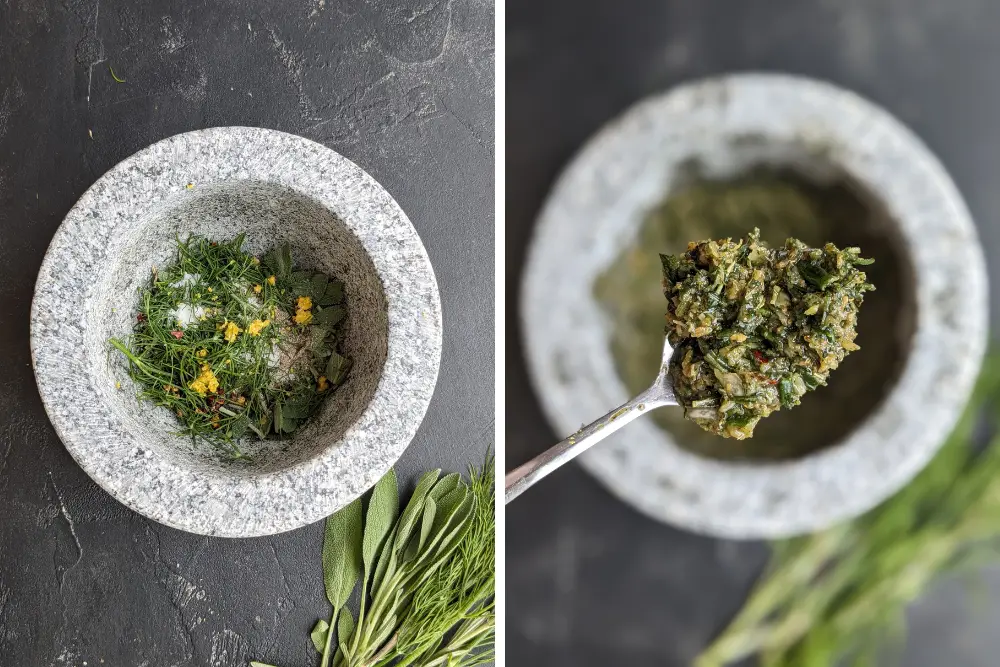
In a mortar and pestle, crush the fennel seeds first. Then add garlic, rosemary, sage, dill, lemon zest, salt, pepper, and red pepper flakes, followed by olive oil. Smash until all ingredients combine into a paste. If using a food processor, add all ingredients and pulse until a paste forms. If it’s too thick, add a touch of olive oil.
Step 2: Rub the Pork Loin
Rub the garlic-herb paste all over the pork loin roast evenly.
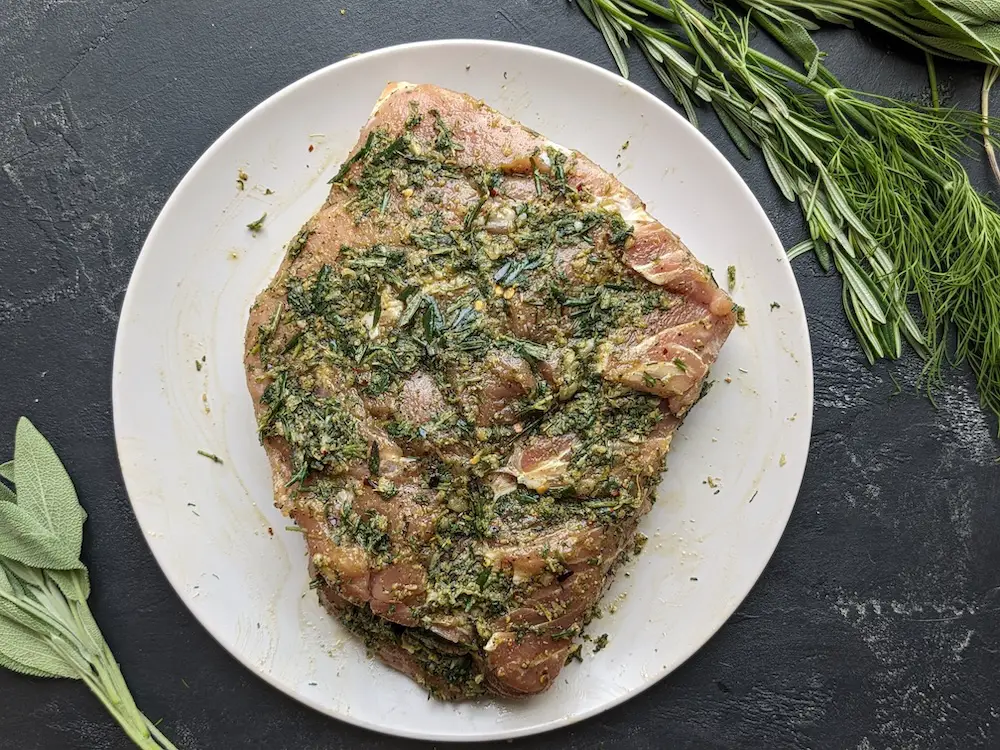
Step 3: Seal the Pork to Marinate
Place the seasoned pork loin in a vacuum-sealed bag or zip-top bag. Remove the air as much as possible and leave it in the fridge overnight.
Step 4: Preheat the Water Bath
Set your immersion circulator to your desired temperature. Let the water bath preheat.
Step 5: Cook in the Water Bath
Submerge the sealed pork loin in the preheated water bath. If using a ziptop bag, employ the water displacement method to remove as much air as possible and clip the top of the bag on the edge of your cooking vessel. Depending on your preferred doneness, let it cook for 3-5 hours.
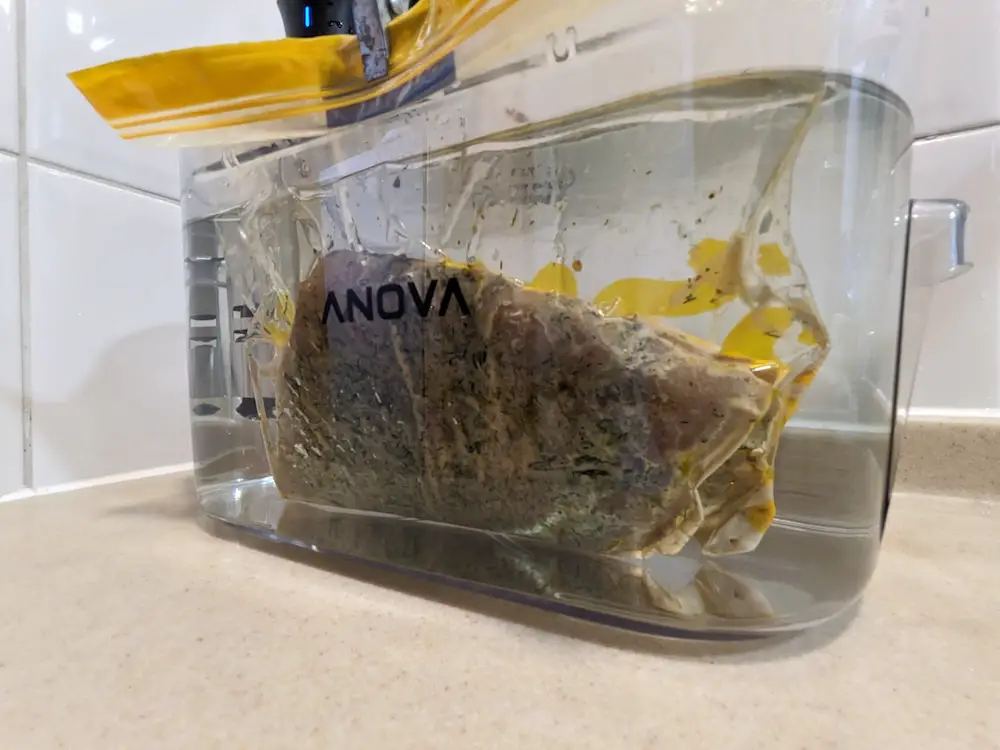
Step 6: Sear or Broil for Color
Pat the pork loin dry and reserve the cooking liquid from the bag. Heat a cast-iron skillet over high heat, add some oil, and sear both sides until golden brown, for about 1 minute on each side. You can also put the pork under a preheated broiler for a few minutes.
Step 7: Make the Serving Sauce
Pour the reserved liquid from the bag into a saucepan, bring to a boil, and strain it. Whisk in honey and lemon juice to taste.
Step 8: Serve
Slice the pork loin into thick slices, garnish with fresh herbs, and drizzle with the serving sauce before serving.
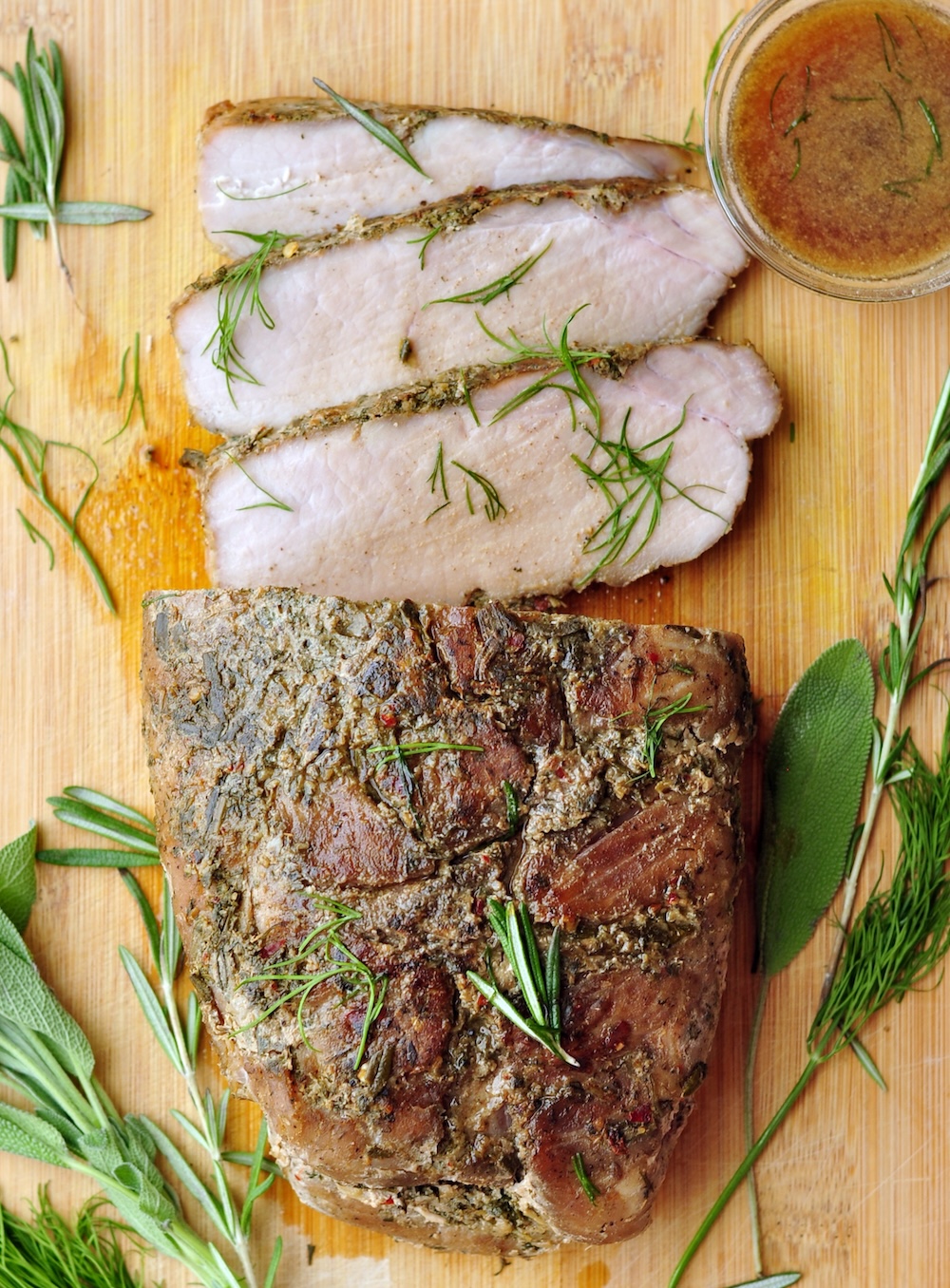
Serving Suggestions
- This sous vide pork loin pairs perfectly well with the Crispy Fennel Apple Salad.
- Also coated with garlic and herbs, Garlic Paprika Sous Vide Potatoes complement the juicy pork.
- A mix of roasted carrots, parsnips, and Brussels sprouts adds color and nutritional balance.
- Sautéed green beans, toasted almonds, and lemon juice provide a crunchy, fresh contrast.
- A fresh sous vide corn salad with bell peppers, avocados, black beans, and garlic lemon aioli brings zesty brightness.
StreetSmart Sous Vide Tips
- Fat cap on or off? I wouldn’t even think about trimming the fat for traditional cooking methods because that’s the key to keeping the pork loin juicy. But with the sous vide method, your pork will still be juicy and tender even if you trim the fat. Removing the fat is okay if you are conscious of your calorie intake.
- Storage: If you cook for one or two, halve the roast, put the halves in two cooking bags to sous vide, and freeze one portion for later. I sliced the pork and packed it into individual portions to freeze.
- Creativity with leftovers:
- Pork Pasta: Dice leftover pork and toss it with pasta, a light sauce, and steamed broccoli.
- Pork Grain Bowls: Build a nutritious grain bowl with quinoa or brown rice, mixed greens, roasted veggies, and sliced pork.
- Pork Tacos: Shred the leftover pork, warm it with spicy seasoning, and served in tortillas with avocado and cabbage.
- Pull-apart Sliders: Heat the pork with barbecue sauce and serve on mini slider buns with coleslaw.
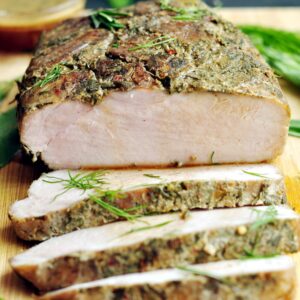
Sous Vide Pork Loin in Garlic-Herb Marinade Recipe
- Prep Time: 15 minutes
- Marinating Overnight:
- Cook Time: 3 hours
- Total Time: 3 hours 15 minutes + Marinating Time
- Yield: 6–8 servings 1x
- Category: Main Dish
- Method: Sous Vide
- Cuisine: American
- Diet: Gluten Free
Description
This sous vide pork loin roast in a green garlic-herb marinade is a foolproof way to easily make a restaurant-quality meal at home.
Ingredients
- 3–4 pounds pork loin roast
For the garlic-herb marinade:
- 1 teaspoon fennel seeds
- 5 cloves garlic, peeled and crushed
- 2 tablespoons fresh rosemary, chopped
- 2 tablespoons fresh sage, chopped
- 3 tablespoons fresh dill, chopped
- 1 tablespoon sea salt
- 1 teaspoon ground black pepper
- 3/4 teaspoon red pepper flakes
- Zest of 1 lemon
- 2 tablespoons olive oil (more for searing)
For the serving sauce:
- Juice from the cooking bag
- 1 teaspoon honey
- Lemon juice, to taste
Instructions
- Make the Garlic-Herb Marinade: Crush fennel seeds in a mortar and pestle. Add garlic, rosemary, sage, dill, salt, pepper, red pepper flakes, lemon zest, and olive oil. Smash the marinade ingredients until the mixture turns into a paste. Alternatively, you can use a food processor for this step.
- Marinate the Pork Loin Roast: Trim the fat or leave it on if you prefer. Score the roast on both sides with a sharp knife. Rub the garlic-herb paste all over the pork. Transfer to a large ziptop bag and marinate it in the fridge overnight.
- Sous Vide the Pork: When ready to cook, preheat water to 140°F (60°C) for medium, 135°F (57°C) for medium-rare, or 145°F (63°C) for well-done using a sous vide machine. Submerge the pork into the water bath using the water displacement method. Set the timer for 3-5 hours.
- Finish the Pork: Remove the pork from the water bath once the timer goes off. Open the bag and transfer the pork to a large plate, reserving the cooking juice in the bag. Heat a cast iron skillet over medium-high heat. Pat the pork dry with paper towels. Once the skillet is hot, add a splash of olive oil and place the pork into the skillet to sear, about one minute on each side, pressing it down using a pot lid. Once the pork is golden brown outside, transfer it onto a cutting board to rest. Alternatively, you can place the pork under a broiler over high heat for 5-7 minutes to finish.
- Make the Serving Sauce: Pour the cooking juice from the bag into the same skillet. Bring it to a boil, scraping off the brown bits from the bottom of the skillet. Strain the sauce through a fine mesh strainer. Stir in honey and a squeeze of lemon juice.
- Serve: Slice the pork roast, garnish with fresh herbs if desired, and serve it with the sauce.
Nutrition
- Serving Size: 1 serving
- Calories: 293
- Sugar: 0.9g
- Sodium: 995.8mg
- Fat: 8.8g
- Saturated Fat: 2.2g
- Trans Fat: 0g
- Carbohydrates: 3.7g
- Fiber: 1.1g
- Protein: 48g
- Cholesterol: 147.3mg
About the Author
Sharon Chen is an Integrative Nutrition Health Coach and author of the Complete Sous Vide Cookbook. She believes food not only brings healing but also connection. As the creator of StreetSmart Kitchen, she aims to make meal prep easier than ever and help you find balance, ease, joy, and simplicity in the kitchen as you improve your well-being.



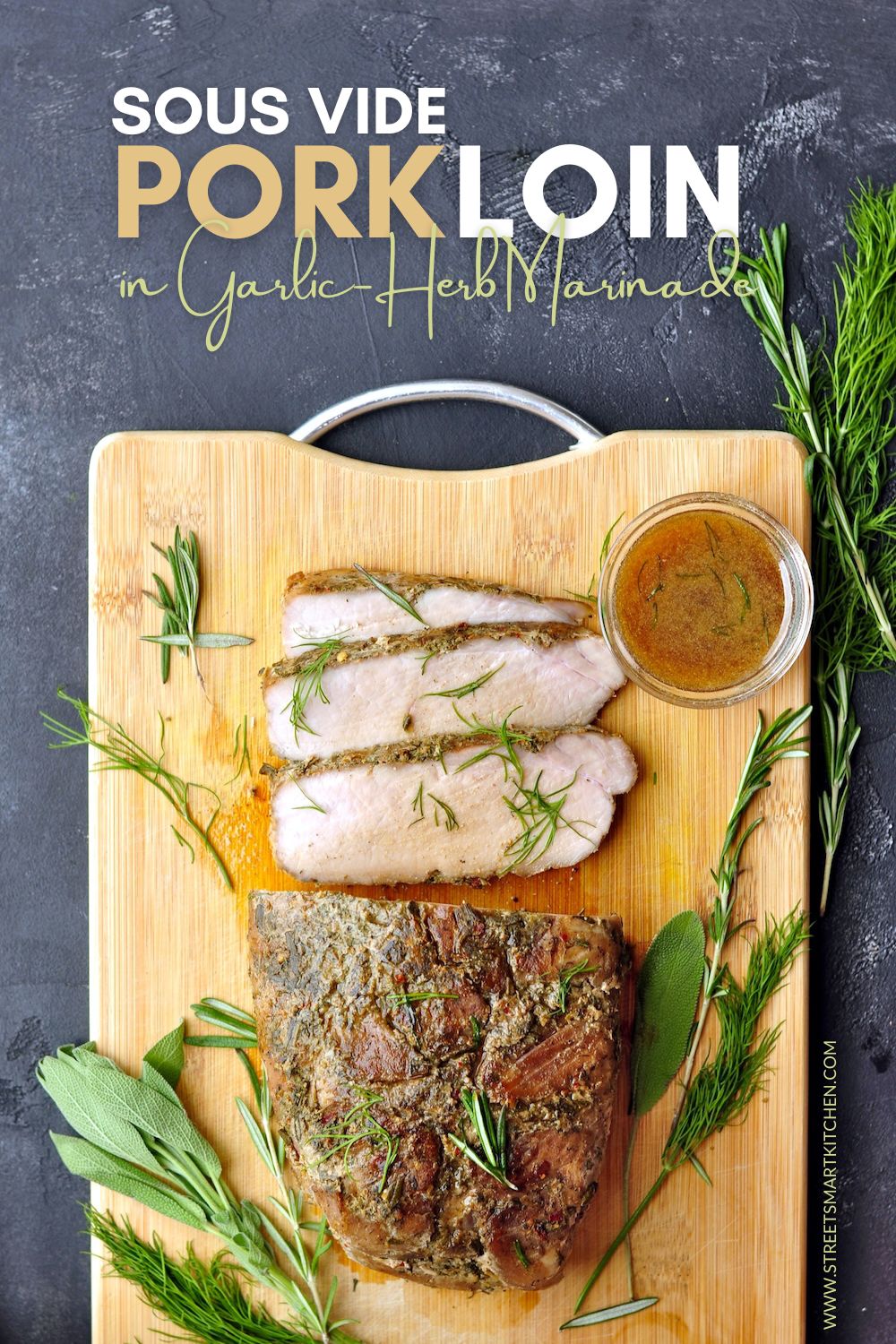
Made this last weekend. It was exceptional. I wouldn’t change anything in the recipe, but a couple of process notes:
– I failed to remove all of the herb coating post sous vide and it burned in the pan during searing, resulting in an unusable fond. I’d suggest noting that the surface should be carefully wiped clean before searing.
– Had very little juice in the bag at the end of sous vide, not enough to make a pan sauce (which I attempted after cleaning off those burned bits). Next time I’ll make sure I have some chicken stock or apple cider defrosted just in case.
Hey David,
Thanks so much for sharing your experience making this recipe. The process notes are super helpful!
– To prevent burning, perhaps broil to finish next time. That will avoid the immediate contact of the heat.
– I see. Not all pork loin pieces are equal. 🙂
Appreciate you trying this recipe and taking the time to write the comment, David!
The garlic herb marinade on this sous vide pork was absolutely stunning. It was so refreshing and tasty! soooo good!
So glad to hear that, Paula! Thanks for the comment.
Sous vide results in such tender cuts of meat and I cannot wait to try this recipe out – that marinade sounds so good!
Yes, sous vide is amazing! Can’t wait to hear what you think.
I love the sous vide method for this pork roast–the pork came out so juicy and flavorful. Will definitely make it again!
Yay! Thank you for making it, Ashley!
The marinade is so flavorful. Can’t wait to try this recipe. Pinned.
Awesome! Thanks Kushi!
I love sous vide but I haven’t yet used it to cook pork. This recipe will change that…it sounds absolutely delicious! I’m definitely filing away that marinade recipe for pork chops too.
Oh, the marinade is gonna be great on chops!